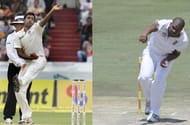A hundred wickets in Test match cricket isn’t a huge milestone; it usually is a sweet milestone. The first 100, like a first love or a first bike, are always special. But there have been players who have made it a huge milestone by the sheer force with which they burst through that barrier. The rapidity, the fervour and the gusto with which they romp to the 100 wicket mark is admirable. When that happens, the world can sit up and take notice. In that context, we are quite fortunate to witness a tussle right now between two bowlers who couldn’t have been more different. Ravichandran Ashwin, even as I write this article, has 90 wickets in his 16th Test. Vernon Philander has 89 wickets from 16 completed Tests. That’s close. Amongst the current crop of players, Ajmal has been the fastest to 100 in 19 Tests.
If you are one for stats, both Ashwin and Philander have a genuine opportunity to be their country’s fastest to 100 wickets. Presently, Steyn is South Africa’s fastest to 100, having done so in 20 Tests. Erapalli Prasanna is India’s fastest, notching 100 in the same number of Tests – 20. Given the current form of both bowlers, they are most likely to reach 100 before the 20th, at least equalling Ajmal’s record. Ashwin might do well to add to his tally in the second innings, as the next Test he would play would be in South Africa. He might still prefer the bounce he will get, but the pitches wouldn’t be as conducive to spin as some of the Indian pitches have been. George Lohmann from England has done it in 16, a record that has stood for more than a century and might stand for a while longer.
Those who don’t believe in stats can smirk at this one. Those who do can rave about it through endless debates. Interestingly, Ashwin and Philander’s Test careers are significant in one aspect – they still have to prove their credentials in unfriendly conditions. Philander has to take wickets on the subcontinent pitches and Ashwin, who wasn’t very effective in Australia, has to get more abroad. In that context, the South Africa tour is an important one for him as much as it is for a batsman like Pujara, who is considered technically immaculate. What makes me love both the players – Ashwin and Philander – is the fact that they don’t look sensational except for the wickets tally. Philander doesn’t have Steyn’s pace. Ashwin doesn’t have Warne or Murali’s turn. They are thinking cricketers who make the ball do just enough to take wickets. A great example would be the way Ashwin has been getting some of the Aussie batsmen bowled around their legs. Philander owns the corridor of uncertainty, much like McGrath did. He is nippy and at 130 to 135kph, he makes the ball deviate just enough off the pitch either way to pick up the wickets.
History will provide us with a caveat; there have been prodigies who raced away to the first 50 or 100 and then virtually disappeared. They couldn’t adapt to the changes in the game. They probably couldn’t adapt to the batsmen who figured them out. That would be the greatest test for Philander and Ashwin. Repeating the pace of their first 100 would be a Herculean effort. At some stage, they might slow down and feel the pressure of expectation build upon them. And then, we might get to actually find out if the world indeed has found a new pace or spin sensation. The game of Test cricket needs sensations. Murali, Warne and Kumble have left huge boots to fill and so have bowlers like McGrath and Pollock, who come once in a generation. We have already seen what an opening line-up with Philander and Steyn could do. We are seeing the resurgence of India against Australia on the back of Ashwin’s improved performance after the England debacle. Let’s hope they aren’t actually in their final gear yet.
Follow IPL Auction 2025 Live Updates, News & Biddings at Sportskeeda. Get the fastest updates on Mega-Auction and cricket news

